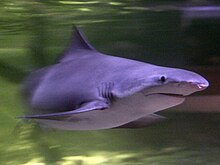Speartooth shark
| Speartooth shark | |
|---|---|

| |
| Scientific classification | |
| Domain: | Eukaryota |
| Kingdom: | Animalia |
| Phylum: | Chordata |
| Class: | Chondrichthyes |
| Subclass: | Elasmobranchii |
| Subdivision: | Selachimorpha |
| Order: | Carcharhiniformes |
| Family: | Carcharhinidae |
| Genus: | Glyphis |
| Species: | G. glyphis
|
| Binomial name | |
| Glyphis glyphis (J. P. Müller & Henle, 1839)
| |

| |
| Range of the speartooth shark | |
The speartooth shark (Glyphis glyphis) is a rare species of
Preying on
Taxonomy

German biologists
Müller and Henle's
Distribution and habitat
Juvenile and subadult speartooth sharks are found in a few large, mangrove-lined tropical rivers in northern Australia and New Guinea, from the estuary to hundreds of kilometers upstream; a single possible record from the South China Sea exists.[3][7] In Queensland, it occurs in the Wenlock, Ducie, and Bizant Rivers, and perhaps also the Normanby, Hey, and Embly Rivers. In the Northern Territory, it is known from the Adelaide River and the Alligator Rivers. The river sharks in the Ord River of Western Australia may also be of this species.[6][8] In New Guinea, this species has been reported from Daru island, near Port Romilly and in the Fly River.[9][10]
Newborn to subadult speartooth sharks exclusively inhabit areas with fast tidal currents and muddy bottoms; the flowing water produces heavy turbidity, such as that <1% of sunlight penetrates beyond a depth of 1 m (3.3 ft). The salinity level of these waters range from nearly fresh (0.8 ppt) to nearly marine (28 ppt), and temperatures range from 25 to 33 °C (77 to 91 °F). Younger sharks are generally found further upstream than older ones. A study that tracked three individuals in the Adelaide River reported that they moved upstream with the flooding tide and downstream with the ebbing tide, averaging 10–12 km (6.2–7.5 mi) each way. The average swimming depth was determined for one individual to be 7.7 m (25 ft), in the middle of the water column.[11] Adults were entirely unknown until 2014, when three specimens (two males and one female) were documented by scientists visiting fishing villages on Daru island, Papua New Guinea. All three were caught in coastal waters off the island.[10] No evidence exists of segregation by sex.[8]
Recently in 2024 a new population where found in the Roper River of the Northern Territory, the first time ever documented living in that area, there was enough living specimens for a viable population and keeping the species alive.
Description
Without any known adult specimens, the maximum size of this species has historically been labelled with considerable uncertainty. In 2014, the first known adults were documented and on this basis it reaches a length around 2.6 m (8.5 ft).[10] The speartooth shark has a streamlined, rather robust body with a short, wide head. The snout is flattened, with large nostrils divided into incurrent and excurrent openings by large, triangular flaps of skin. The eyes are small and equipped with nictitating membranes (protective third eyelids). The sizable, arched mouth has very short furrows at the corners. It has 26–29 upper and 27–29 lower tooth rows. The teeth are tall and upright; those in the upper jaw are wide and triangular with serrated edges, while those in the lower jaw are narrow and spear-like with serrations only near the tip, and tiny cusplets at the base in very young individuals. There are five pairs of gill slits, with the first pair longer than the others.[5][9]
The large
Biology and ecology
The speartooth shark seems to be relatively sluggish in nature, moving with the tides so as to conserve energy. Its activity levels are unaffected by day or night, reflecting the constant darkness of its environment.
Human interactions
The speartooth shark is not known to pose a danger to humans.
The range of conservation threats faced by the speartooth shark, coupled with its small population and restricted range and habitat preferences, have led the International Union for Conservation of Nature to assess it as vulnerable.[1] Furthermore, in Australia, it has been listed as critically endangered on the 1999 Commonwealth Environment Protection and Biodiversity Conservation Act. The speartooth shark is within the scope of the Sawfish and river shark multispecies recovery plan made under the EPBC Act.[13] It has also been listed as vulnerable on the 2000 Territory Parks and Wildlife Conservation Act, though a management plan has yet to be enacted. Sharks in the Kakadu and Rinyirru National Parks are protected somewhat from habitat alteration, if not fishing.[6][8] No regulations restrict the capture of this species in Papua New Guinea.[10]
References
- ^ . Retrieved 19 November 2021.
- ^ Müller, J. & F.G.J. Henle (1838–41). Systematische Beschreibung der Plagiostomen. Veit und Comp. p. 40.
- ^ a b Roberts, T. R. (21 May 2007). "A new record for the speartooth carcharhinid shark Glyphis glyphis from Pulo Condor, South China Sea". Natural History Bulletin of the Siam Society. 54 (2): 279–283.
- ISBN 92-5-101384-5.
- ^ ISBN 1-921424-18-2(invalid, listed in publication).
- ^ a b c d Department of the Environment, Water, Heritage and the Arts (2010). Glyphis glyphis – Speartooth Shark. Species Profile and Threats Database, Department of the Environment, Water, Heritage and the Arts, Canberra. Retrieved on 13 September 2010.
- ^ .
- ^ a b c d e Stevens, J.D., R.D. Pillans and J. Salini (2005). Conservation Assessment of Glyphis sp. A (Speartooth Shark), Glyphis sp. C (Northern River Shark), Pristis microdon (Freshwater Sawfish) and Pristis zijsron (Green Sawfish). CSIRO Marine Research, Hobart, Tasmania. Retrieved on 13 September 2010.
- ^ ISBN 978-0-674-03411-2.
- ^ PMID 26445387.
- ^ doi:10.3354/esr00206.
- ^ Froese, Rainer; Pauly, Daniel (eds.) (2010). "Glyphis glyphis" in FishBase. September 2010 version.
- ^ Department of the Environment (2015). Sawfish and river shark multispecies recovery plan. Department of the Environment, Canberra.

